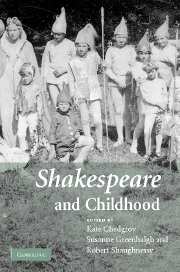Book contents
- Frontmatter
- Contents
- Acknowledgements
- Notes on contributors
- Note on the text
- 1 Introduction
- PART 1 SHAKESPEARE'S CHILDREN
- 2 Introduction: ‘What, are they children?’
- 3 Little princes: Shakespeare's royal children
- 4 Father-child identification, loss and gender in Shakespeare's plays
- 5 Character building: Shakespeare's children in context
- 6 Coriolanus and the little eyases: the boyhood of Shakespeare's hero
- 7 Procreation, child-loss and the gendering of the sonnet
- PART 2 CHILDREN'S SHAKESPEARES
- APPENDICES
- Index
6 - Coriolanus and the little eyases: the boyhood of Shakespeare's hero
Published online by Cambridge University Press: 22 September 2009
- Frontmatter
- Contents
- Acknowledgements
- Notes on contributors
- Note on the text
- 1 Introduction
- PART 1 SHAKESPEARE'S CHILDREN
- 2 Introduction: ‘What, are they children?’
- 3 Little princes: Shakespeare's royal children
- 4 Father-child identification, loss and gender in Shakespeare's plays
- 5 Character building: Shakespeare's children in context
- 6 Coriolanus and the little eyases: the boyhood of Shakespeare's hero
- 7 Procreation, child-loss and the gendering of the sonnet
- PART 2 CHILDREN'S SHAKESPEARES
- APPENDICES
- Index
Summary
Ros. Where have you been?
Player. Roundabout. A nest of children carries the custom of the town. Juvenile companies, they are the fashion. But they cannot match our repertoire … we'll stoop to anything if that's your bent … (He regards ROS meaningfully, but ROS returns the stare blankly.)
Ros. They'll grow up.
This chapter explores an important context for Shakespeare's engagement with childhood: the performances of professional and semi-professional children's companies in the late sixteenth and early seventeenth century. Rather than focusing solely on the influence of specific plays, I examine the impact of children's performance on Shakespeare's dramaturgy in his late tragedy Coriolanus. Child characters are relatively rare in children's company plays; instead, boy actors are required to perform adult roles and to mimic adult status and authority. Their plays, in particular their tragedies, demonstrate a complex interconnection of issues relating to age and masculinity, anxieties about the respective authority of adult and child performance, and concerns about political agency. These preoccupations are reflected in Coriolanus, at the ‘psychological and political heart’ of which is, as R. B. Parker notes, the term ‘boy’. Shakespeare draws on children's company tragedies such as Samuel Daniel's Philotas (1604) and George Chapman's Bussy D'Ambois (c.1604) and The Conspiracy and Tragedy of Charles, Duke of Byron (1608) to create a military hero who is repeatedly reduced to the status of a boy or youth.
- Type
- Chapter
- Information
- Shakespeare and Childhood , pp. 80 - 95Publisher: Cambridge University PressPrint publication year: 2007
- 2
- Cited by



